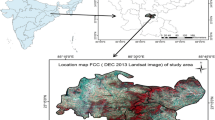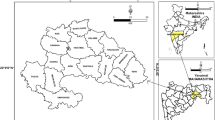Abstract
Extensive livestock grazing even in unsuitable land has increasingly grown in most parts of semi-arid rangeland. Therefore, it is of paramount importance to identify suitable land for livestock grazing for optimum utilization while causing minimum impact to the environment. This paper adapted the schematic model based on the concepts presented by the Food and Agriculture Organization of suitability analysis for optimal grazing management in semi-arid rangeland in Iran. Factors affecting extensive grazing were determined and incorporated into the model. Semi-arid rangeland with variable such as climate and other agents were examined for common types of animal grazing and the advantages and limitations were elicited. Many ecosystem components affect land suitability for livestock grazing but due to time and funding restrictions, the most important and feasible elements were investigated. Within the model parameters, three submodels including water accessibility source, forage production, and erosion sensitivity were considered. Suitable areas at four levels of suitability were determined using geographic information systems. This suitability modeling approach was adopted due to its simplicity and the minimal time required for transforming and analyzing datasets. The most important reducing factors in model suitability were found to be: (a) land use and vegetation cover (in relation to soil erosion sensitivity), (b) the amount of the available forage in comparison with the total production, and (c) the existence of less palatability plants among the pasture plant species (forage production suitability). The results of the study would be beneficial to rangeland managers in devising measures more wisely to cope with the limitations and enhance the health and productivity of the rangelands.





Similar content being viewed by others
References
Abebe A, Legesse D, Peden D (2006) GIS Applications in suitability modeling for livestock production in Tana Sub Basin-Blue Nile River Basin, Ethiopia. Unpublished MSc Thesis, Addis Ababa University, Addis Ababa, Ethiopia
Ahmadi H (2004) Applied geomorphology (vol.1, water erosion). Tehran University Publication, Tehran, Iran
Amiri F (2009a) A GIS model for determination of water resources suitability for goats grazing. Afr J Agr Res 4(1):014–020
Amiri F (2009b) A model for classification of range suitability for sheep grazing in semi-arid regions of Iran. J Livest Res Rur Dev 21(5):68–84
Amiri F (2010) Estimate of erosion and sedimentation in semi-arid basin using empirical models of erosion potential within a geographic information system. Air Soil and Water Res 3:37–44
Amiri F, Shariff ARBM (2012) An approach for analysis of integrated components on available forage in semi-arid rangelands of Iran. World Appl Sci J 17(5):546–556
Amiri F, Shariff ARBM, Tabatabaie T (2012) Application of geographic information systems. In: Alam BM (ed) Monitoring land suitability for mixed livestock grazing using geographic information system (GIS). InTech, Department of Geography & Planning, The University of Toledo, Spain, pp. 253–278. http://dx.doi.org/10.5772/1944
Arzani H, Jangjo M, Shams H, Mohtashamnia S, Fashami M, Ahmadi H, Jafari M, Darvishsefat A, Shahriary E (2006) A model for classification of range suitability for sheep grazing in Central Alborz, Ardestan and Zagros regions. J Sci Tech Agr Nat Res 10(1):273–290
Baniya N (2008) Land suitability evaluation using GIS for vegetable crops in Kathmandu Vally, Nepal, Ph. D. dissertation. University of Berlin,
Baniya N, Boehme M, Baniya S (2009) Physical land suitability assessment for the large cardamom Amomum subulatum Roxb. cultivation in hills of Kathmandu Valley. Chinese J Popul Res and Env 7(4):59–63
Bennett J, Lent P, Harris P (2007) Dry season foraging preferences of cattle and sheep in a communal area of South Africa. Afr J Range Forage Sci 24(3):109–121. doi:10.2989/AJRFS.2007.24.3.1.294
Bizuwork A, Taddese G, Peden D, Jobre Y, Getahun Y (2006) Application of geographic information systems (GIS) for the classification of production systems and determination of grazing pressure in uplands of the Awash River Basin, Ethiopia. Ethiop Vet J 10(1):41–49
Breman H, De Wit C (1983) Rangeland productivity and exploitation in the Sahel. Science 221(4618):1341–1347
Collins MG, Steiner FR, Rushman MJ (2001) Land-use suitability analysis in the United States: historical development and promising technological achievements. Environ Manage 28(5):611–621
Cook CW (1954) Common use of summer range by sheep and cattle. J Range Manage 7(1):10–13
Dessalegn G (2010) Remote sensing and GIS based suitability analysis for livestock production in Yabello District. Addis Ababa University, Southern Ethiopia
FAO (1976) A framework for land evaluation. Soils bulletin 32. Food and Agriculture Organization of the United Nations, Rome, Italy
FAO (1991) Guidelines: land evaluation for extensive grazing, issue 58 of FAO soils bulletin. Food and Agriculture Organization of the United Nations, Rome, Italy
FAO (2002) Agricultural drainage water management in arid and semi-arid areas. Food and Agriculture Organization of United Nations, Rome, Italy
FAO (2007) Land evaluation towards a revised framework. Food and Agriculture Organization of the United Nations, Rome, Italy
Farahpour M, Van Keulen H, Sharifi M, Bassiri M (2004) A planning support system for rangeland allocation in Iran with case study of Chadegan sub-region. Rangeland J 26(2):225–236
Fitumukiza DM (2004) Evaluating rangeland potentials for cattle grazing in a mixed farming system. ITC, Netherlands
Gavili E, Ghasriani F, Arzani H, Vahabi M, Amiri F (2011) Determine water resources accessibility for sheep grazing by GIS technology (case study: Feraidun Shahr rangeland in Isfahan Province). J Applied RS and GIS Tech in Nat Res Sci 1(1):89–99
Guenther KS, Guenther GE, Redick PS (2000) Expected-use GIS maps. Rangelands J 22(2):18–20
Guo ZG, Liang TG, Liu XY, Niu FJ (2006) A new approach to grassland management for the arid Aletai region in Northern China. Rangeland J 28(2):97–104
Harper SJ, Westervelt JD, Shapiro A-M (2002) Modeling the movements of cowbirds: application towards management at the landscape scale. Nat Resour Model 15(1):111–131. doi:10.1111/j.1939-7445.2002.tb00082.x
Holechek JL, Pieper RD, Herbel CH (1995) Range management: principles and practices, 2nd edn. Prentice-Hall, USA
Hoobler BM, Vance GF, Hamerlinck JD, Munn LC, Hayward JA (2003) Applications of land evaluation and site assessment (LESA) and a geographical information system in East Part Couny, Wyoming. J Soil Water Conserv 58(2):105–112
Hopkins LD (1977) Methods for generating land suitability maps: a comparative evaluation. J Am I Planners 43(4):386–400
Jayasinghe PKS, Machida T (2008) Web-based GIS online consulting system with crop land suitability idetification. Agr Inform Res 17(1):13–19
Kalogirou S (2002) Expert systems and GIS: an application of land suitability evaluation. Comput Environ Urban 26(2):89–12
Kioko J, Kiringe JW, Seno SO (2012) Impacts of livestock grazing on a savanna grassland in Kenya. J Arid Land 4(1):29–35. doi:10.3724/SP.J.1227.2012.00029
Liu Y-S, Wang J-Y, Guo L-Y (2006) GIS-based assessment of land suitability for optimal allocation in the Qinling Mountains, China. Pedosphere 16(5):579–586
McArthur L, Boland J, Tiver F (2006) A model to detect grazing sensitivity of myoporum platycarpum in the arid rangelands of South Australia. Nat Resour Model 19(4):587–607. doi:10.1111/j.1939-7445.2006.tb00195.x
Neameh B (2003) Land evaluation for land use planning with especial attention to sustainable fodder production in the Rouzeh Chai catchment of Orumiyeh area, Iran. MS unpublished Thesis. ITC, Netherlands
Quaas MF, Baumgärtner S (2012) Optimal grazing management rules in semi-arid rangelands with uncertain rainfall. Nat Resour Model 25(2):364–387. doi:10.1111/j.1939-7445.2011.00110.x
Skonhoft A (1999) Exploitation of an unmanaged local common on the problems of overgrazing, regulation and distribution. Nat Resour Model 12(4):461–479. doi:10.1111/j.1939-7445.1999.tb00022.x
Sonneveld MPW, Hack-ten Broeke MJD, van Diepen CA, Boogaard HL (2010) Thirty years of systematic land evaluation in the Netherlands. Geoderma 156(3–4):84–92
Tietjen B, Jeltsch F (2007) Semi-arid grazing systems and climate change: a survey of present modelling potential and future needs. J Appl Ecol 44(2):425–434. doi:10.1111/j.1365-2664.2007.01280.x
Vallentine JF (2001) Grazing management, 2nd edn. Elsevier, New York, p 460
Venkataratnam L (2002) Remote sensing and GIS in agricultural resources management. In: First National Conference on Agro-Informatics, INSAIT
Watkinson A, Ormerod S (2001) Grasslands, grazing and biodiversity: editors’ introduction. J Appl Ecol 38(2):233–237. doi:10.1046/j.1365-2664.2001.00621.x
Yeganeh H, Khajedein SJ, Amiri F, Mohamed Shariff AR (2012) Monitoring rangeland ground cover vegetation using multi temporal MODIS data. Arab J Geo. doi:10.1007/s12517-012-0733-0
Youssef AM, Pradhan B, Tarabees E (2011) Integrated evaluation of urban development suitability based on remote sensing and GIS techniques: contribution from the analytic hierarchy process. Arab J Geo 4(3):463–473. doi:10.1007/s12517-009-0118-1
Author information
Authors and Affiliations
Corresponding author
Rights and permissions
About this article
Cite this article
Amiri, F., bin Mohamed Shariff, A.R., Tabatabaie, T. et al. A geospatial model for the optimization grazing management in semi-arid rangeland of Iran. Arab J Geosci 7, 1101–1114 (2014). https://doi.org/10.1007/s12517-013-0840-6
Received:
Accepted:
Published:
Issue Date:
DOI: https://doi.org/10.1007/s12517-013-0840-6




